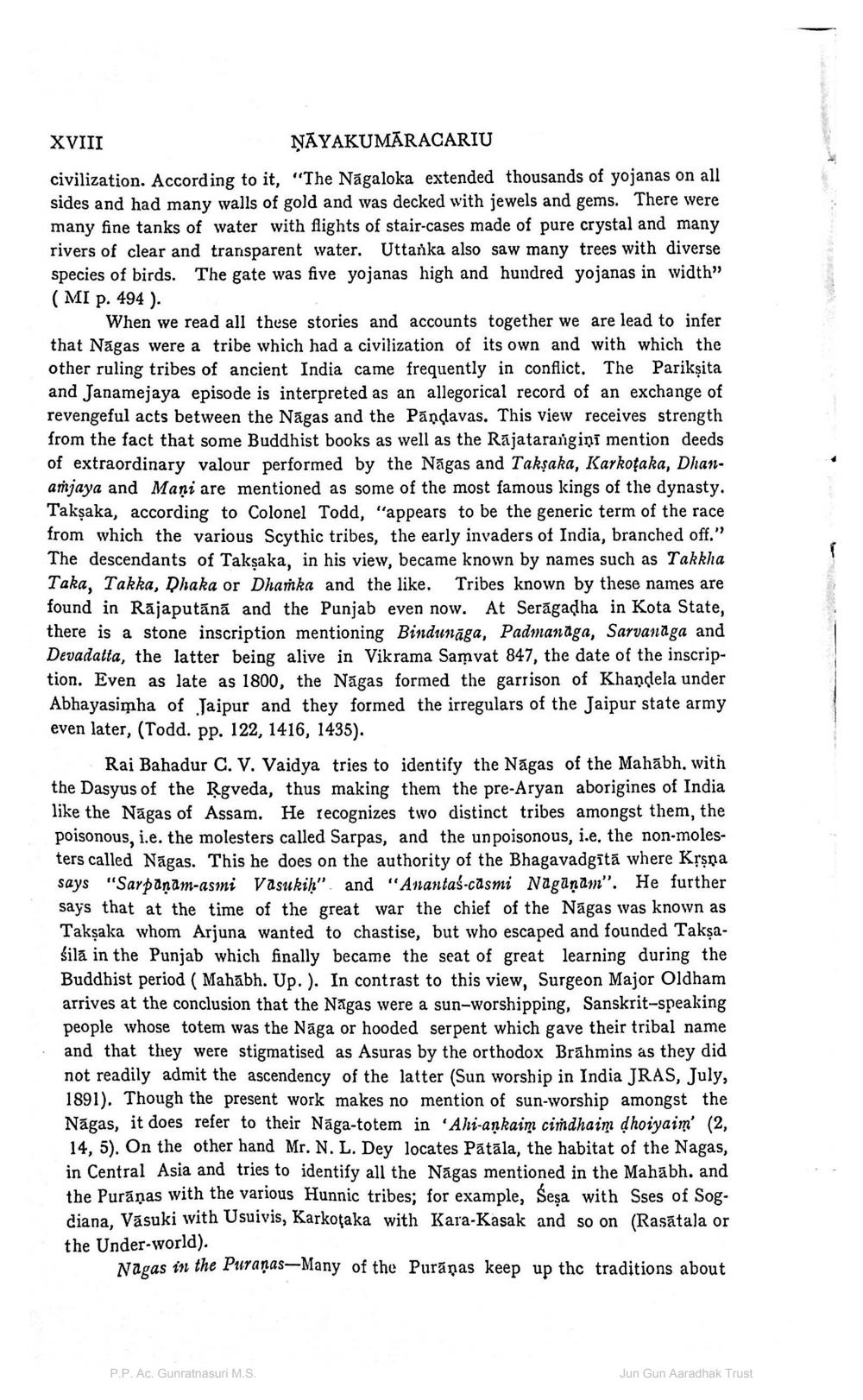________________ XVIII NAYAKUMARACARIU civilization. According to it, "The Nagaloka extended thousands of yojanas on all sides and had many walls of gold and was decked with jewels and gems. There were many fine tanks of water with flights of stair-cases made of pure crystal and many rivers of clear and transparent water. Uttarka also saw many trees with diverse species of birds. The gate was five yojanas high and hundred yojanas in width" (MI p. 494 ). When we read all these stories and accounts together we are lead to infer that Nagas were a tribe which had a civilization of its own and with which the other ruling tribes of ancient India came frequently in conflict. The Pariksita and Janamejaya episode is interpreted as an allegorical record of an exchange of revengeful acts between the Nagas and the Pandavas. This view receives strength from the fact that some Buddhist books as well as the Rajatarangini mention deeds of extraordinary valour performed by the Nagas and Taksaka, Karkotaka, Dhanamjaya and Mani are mentioned as some of the most famous kings of the dynasty. Taksaka, according to Colonel Todd, "appears to be the generic term of the race from which the various Scythic tribes, the early invaders of India, branched off." The descendants of Taksaka, in his view, became known by names such as Takkha Taka, Takka, Dhaka or Dhamka and the like. Tribes known by these names are found in Rajaputana and the Punjab even now. At Seragadha in Kota State, there is a stone inscription mentioning Bindunaga, Padmanaga, Sarvanaga and Devadatta, the latter being alive in Vikrama Samvat 847, the date of the inscription. Even as late as 1800, the Nagas formed the garrison of Khandlela under Abhayasimha of Jaipur and they formed the irregulars of the Jaipur state army even later, (Todd. pp. 122, 1416, 1435). Rai Bahadur C. V. Vaidya tries to identify the Nagas of the Mahabh, with the Dasyus of the Rgveda, thus making them the pre-Aryan aborigines of India like the Nagas of Assam. He recognizes two distinct tribes amongst them, the poisonous, i.e. the molesters called Sarpas, and the unpoisonous, i.e. the non-molesters called Nagas. This he does on the authority of the Bhagavadgita where Krsna says "Sarpanam-asmi Vasukih" and "Anantas-casmi Nagunam". He further says that at the time of the great war the chief of the Nagas was known as Taksaka whom Arjuna wanted to chastise, but who escaped and founded Taksasila in the Punjab which finally became the seat of great learning during the Buddhist period (Mahabh. Up.). In contrast to this view, Surgeon Major Oldham arrives at the conclusion that the Nagas were a sun-worshipping, Sanskrit-speaking people whose totem was the Naga or hooded serpent which gave their tribal name and that they were stigmatised as Asuras by the orthodox Brahmins as they did not readily admit the ascendency of the latter (Sun worship in India JRAS, July, 1891). Though the present work makes no mention of sun-worship amongst the Nagas, it does refer to their Naga-totem in 'Ali-ankaim cimdhaim dhoiyaim' (2, 14, 5). On the other hand Mr. N. L. Dey locates Patala, the habitat of the Nagas, in Central Asia and tries to identify all the Nagas mentioned in the Mahabh. and the Puranas with the various Hunnic tribes; for example, Sesa with Sses of Sog. diana. Vasuki with Usuivis, Karkotaka with Kara-Kasak and so on (Rasatala or the Under-world). Nagas in the Puranas-Many of the Puranas keep up thc traditions about P.P.AC. Gunratnasuri M.S. Jun Gun Aaradhak Trust




